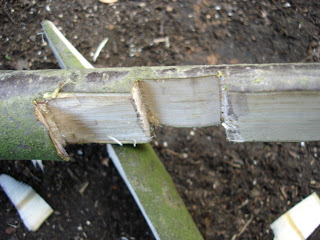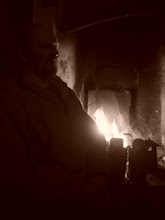
Scandinavian Pot Hanger.
In the world of bushcraft there is an amazing array of different suspension systems designed to assist us in hanging a pot above our camp fire to boil water or help us slowly simmer that backwoods stew.
But be it a Waugan stick, a dingle or a cooking crane of the most cunning design one defect in them all is the fact that the ‘crafter’ needs to spend time searching out the correct materials. ‘Not a hardship,’ I hear you cry, and you’d be right as there is always pleasure to be had, and wonders to be found while searching the woodland for that hook or forked stick of correct length and size.
But imagine that time is short before darkness descends upon you and its raining or your choice of materials are limits as might be the case in the northern boreal forests.
Well, all is not lost and thanks to the cunning wilderness living skills of a very good Swedish friend of mine, Preben Mortensen the granddaddy of Swedish survival, the wily outdoors person can quickly carve a Scandinavian pot hanger and is so doing not only impress their friends with their knowledge and knife craft but also, perhaps more importantly, quickly get the pot over the fire for that essential warming brew or meal.
So where do we begin?
In the world of bushcraft there is an amazing array of different suspension systems designed to assist us in hanging a pot above our camp fire to boil water or help us slowly simmer that backwoods stew.
But be it a Waugan stick, a dingle or a cooking crane of the most cunning design one defect in them all is the fact that the ‘crafter’ needs to spend time searching out the correct materials. ‘Not a hardship,’ I hear you cry, and you’d be right as there is always pleasure to be had, and wonders to be found while searching the woodland for that hook or forked stick of correct length and size.
But imagine that time is short before darkness descends upon you and its raining or your choice of materials are limits as might be the case in the northern boreal forests.
Well, all is not lost and thanks to the cunning wilderness living skills of a very good Swedish friend of mine, Preben Mortensen the granddaddy of Swedish survival, the wily outdoors person can quickly carve a Scandinavian pot hanger and is so doing not only impress their friends with their knowledge and knife craft but also, perhaps more importantly, quickly get the pot over the fire for that essential warming brew or meal.
So where do we begin?

First, select two thumb thick sticks with a forked off shoot at one end and one short straight section as pictured above.
Green wood while not essential is best for this being easiest to carve and less likely to suffer damage from fire in the short term. Try to select the wood from non-toxic trees or trees without a heavy resinous sap by nature as we don’t want to risk contamination our food even if this risk is small
A tip here is to leave all wood, at this stage, as long as possible so we can measure and trim it later – this will allow us to hang our pot at the optimum height about the fire.
Now having selected our materials and checked they are sound and not rotten or weak in anyway (don’t want our dinner dropping into the fire now do we?) we can happily make our way back to camp where we will work on the next stage of our hangers construction.
Having erected our crane, be it two forked sticks with a cross bar (more correctly called a Waugan (a name predating the turn of the century and as such the correct term given its age and in common usage by our US friends) or a Saster, Speygelia (what we Brits might call a Waugan stick thanks to TV or modern literature) over our fire measure the points where our two branches (once carved) will meet and in so doing lift our pot to the correct height about the fire. Once marked we take our knife and remove approximately half the wood from the poles length (as shown below) remembering to remove the material from the side of the pole away from the fork.

*Note the notched or beaked under cuts carved into the lower ends of the pole will become more apparent later.
Having carved both pieces as above pay particular attention to the removal of the ends of your poles (these being tops furthest away from the forked side branches). These are cut at a 60 degree or so angle so they face away from the carved or exposed wood with the angle going back towards the fork branch side where it is sticking out and as such both should be cut to a length which when placed together and slid into the notches on the adjoining half lock the whole thing together – see below

This done we can fine tune the lengths of our set up, adjusting the height of the pot (not the bottom of the lower forked stick) but so it is at a height where we can hold our hand above the fire for approximately 5 seconds without burning ourselves. This height above the fire will generally (flames going up and down, wind speed ect ect) ensure we boil water or cook food with the minimum risk of it burning if left unattended for short periods of time but also without wasting fuel by needing a hotter or longer burning fire.
I digress however so let us return to task.
Our forked sticks should now interlock but will lack the strength to stay locked together once weight is placed upon them so now we must make ourselves the locking bar. For this take our third shorter piece of wood and carve it into a flat square piece of a size approximate to the forked sticks but wider if placed horizontally across them (for thumb thick sticks your looking at a piece approximately 10mm wide by 20mm high and 80mm long – of course as with all things bushcraft these are only guides and the dimensions of your materials will dictate)

Finally we need to carve the lock itself. Place the finished locking bar across your two poles in a position central to both and mark the poles on the exposed side and across the grain to the width and half the depths of the locking bar.
Then using stop cuts remove the waste material inside these markings as below.
Carve slowly and with care as to much wood being removed will make the final hanger ineffective as the locking bar will not be able to lock the two poles in place.
This done we are finally ready for completion.
Place the two halves of the pot hanger together, their forks should now both be facing outward, and gently tap the locking bar into the carved lock recess. The bar should not slid in easily as its role it to force the two halves apart and thus friction lock the slanted ends tightly into the carved beak notches.
This done we are finally ready for completion.
Place the two halves of the pot hanger together, their forks should now both be facing outward, and gently tap the locking bar into the carved lock recess. The bar should not slid in easily as its role it to force the two halves apart and thus friction lock the slanted ends tightly into the carved beak notches.

Once this is done and the whole hanger is locked tightly together we can trim off the ends of the locking bar so it sits flush to the wood.

Now is the time we can also trim off the forks of our two halves leaving them long enough to take our pots bail arm or handle but not so long as to get in the way during usage. Also remember to remove any other waste material until our finished article looks similar to the below.
This done all that remains is for us to fill the pot and hang it above the fire while we sit back contented in having displayed a new skill which will become a familiar friend on many future trails.

























No comments:
Post a Comment